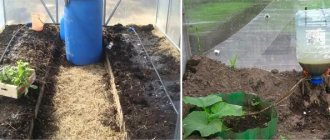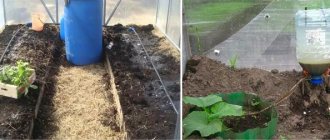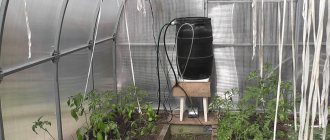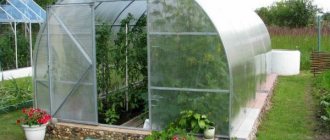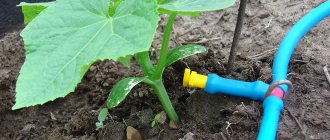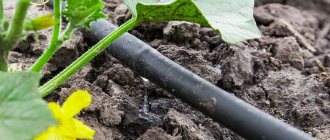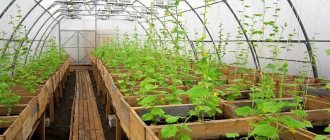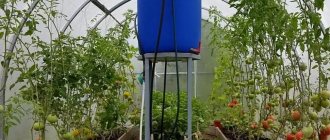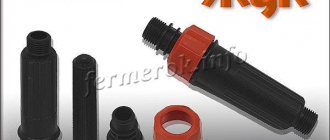By installing drip irrigation in a greenhouse, in an open area or even at home, you no longer have to water the plants manually. Therefore, any gardener and florist would not mind acquiring one. You can do drip irrigation for a greenhouse yourself; in this article we will tell you and show you how. And in the end, we will analyze the options for ready-made systems that operate from a water supply or container.
DIY drip irrigation system assembly
Homemade drip irrigation is not difficult to make.
You must perform the following steps step by step:
- The barrel (up to 200 l) is raised above the ground to a height of up to 2 m. Holes are made in the lid for air access. If it is missing, then cover it with gauze - this is protection from insects and dirt.
- A hole is drilled near the bottom, a tap-tip is installed and the hose is brought in.
- The mains are installed at a slight slope - about 5 cm for every meter. For this, additional pegs are used.
- Pipes (hoses) are not made long - it is better to build several systems. Lay out carefully, do not drag or pull.
- They ensure precise joining of pipes - they are placed in a vice before cutting. Sealed with tow or fum tape. All connecting elements fit very tightly.
- The holes are made small (no more than 2 mm). An awl or nail is suitable for a hose, and a drill for PVC pipes. If you insert pieces of wire, water will flow down them.
- Purchased devices have colored marks - they are placed upward.
- The main hose is secured with a clamp. The lines are washed to prevent blockages, and a plug - a wooden plug - is inserted.
- They check that the water reaches each dropper, and the soil is moistened evenly.
Setup and adjustment
Typically the devices are placed on a platform or tripod . It is important to correctly adjust the sprayer according to the radius and range of the jet. Some devices have a variable tilt angle - from 10 to 360 degrees. This allows you to vary the irrigation range and serve both a small area (within 3 m) and a very large area.
When purchasing a device, you need to pay attention to what parameters this model allows you to vary. If wide variability is a fundamental characteristic, only models that provide the ability to change the range and angle of inclination are suitable.
Calculation of watering time and volume of liquid supplied
The system design allows you to calculate water consumption and tank volume. Calculation example:
- highways - 15 m;
- between nozzles - 20 cm;
- required number of droppers - 1500/20=75 pcs.;
- consumption of one - 2 liters per hour;
- all nozzles - 2*75=150 l;
- barrel size - 150.
A long system will require a larger capacity, so several devices are usually made.
Individual watering times are calculated for each plant. Devices that consume 2 liters per hour include:
- cucumbers - for 60 minutes;
- tomatoes - 45 minutes;
- cabbage - 75 min.
Calculation of water supply
Let’s assume that a two-liter bottle is installed as a dispenser, which fills with water in 20 minutes. Accordingly, three bottles or six liters of water will be collected per hour. Watering time is about seven hours (from 10 a.m. to 5 p.m.), so that’s 42 liters of water per day. For example, twelve tomatoes and seven cucumbers grow in a garden bed. It turns out that each plant will receive approximately 2.2 liters of water per day. To reduce the water supply, a so-called nozzle is inserted into the supply tube - a piece of insulation from the wire or simply another thinner tube. If you have a tap, you can regulate the flow directly with it.
With these calculations, it turns out that one barrel of water (200 liters) is enough for five days. Although, in fact, it will last for a longer time, because when the water level in the barrel decreases, the pressure will drop and the irrigation system will “save” water. And the consumption will be more economical the less water there is in the barrel.
Experiments have shown that if the soil is very well mulched, then 1-2 liters of “drip” water will be enough to water one cucumber per day. For peppers and tomatoes, the norm will be two times less. Although, an experienced gardener can determine by eye whether the plant has enough moisture or not. If in doubt, you can simply touch the ground with your finger.
DIY drip irrigation from plastic bottles
For a small area, the simplest system of ordinary plastic bottles is suitable.
They are hung on a peg, with the neck down, and a narrow tube or simply the refill of a ballpoint pen is inserted into it. Be sure to make a hole for air to escape.
The second option is to make holes in the bottom. Here it is important to take into account the type of soil and its ability to absorb moisture, since the number of holes depends on this:
- sandy - 8;
- clay -12.
Their size is small so that the liquid does not spill out quickly. You can make them with a needle.
A simple option is underground watering: the bottle is buried in the ground, and the neck remains above the surface. When the amount of water decreases, add it. The advantage of this method is that there is no crust on the surface that needs to be loosened. For example, in a greenhouse, one tomato bush will need 1 liter of liquid for 7 days.
The holes quickly become clogged if there is clay in the soil. To prevent this:
- put ordinary nylon tights on the part of the container with holes;
- make a little drainage - put burlap or grass in the hole before burying.
This is a good idea for people who are often away. The bottle is placed in the ground, tilted at 30-45° to reduce the water pressure and the rate of its consumption.
Care and maintenance
With proper maintenance, the main problem is clogging of the emitters. To combat this, it is necessary to periodically flush the entire system with clean water under high pressure.
If during operation, fertilizers were supplied through the system, flushing is carried out immediately after this.
Important! Tape-type drip systems often suffer from mechanical damage. It is necessary to monitor garden tools during the process of loosening and fertilizing the soil. It is also important to prevent any slight twisting or bending of the tape.
Automation of drip irrigation
It is possible to automate a drip irrigation system so that it turns on itself on time without human intervention. To do this, use a special device - a controller (timer).
The controller, which has fittings on both sides, is inserted into the drip irrigation pipeline system. It can also be used to control water intake when connected to a pump.
It is possible to do underground irrigation - this drip irrigation is distinguished by the laying of a pipeline that is placed at depth.
Description of ready-made kits
There are ready-made drip irrigation kits on sale depending on the needs of customers.
For the greenhouse
For watering a greenhouse, gardeners prefer the following models:
- "Beetle" for 60 plants . Automated model. Water intake from the tank, irrigation area 18 m2. With electronic timer, connector for connection. The consumption of one dropper is 4 liters. The average price is 2200 rubles.
- "AquaDusya +60" . No automation. Water intake from the tank. There are 60 droppers available. Watering time 40-60 minutes. The average price is 2300 rubles.
For open ground
The following systems are used for watering open ground:
"GARDENA13002-20" .
Water intake from the water supply system. Number of plants – 20 pcs. Hose length – 15 m. With timer, water flow regulator, connector for connection. The average price is 9500 rubles.- "Bug" . Water intake from the water supply system. Possibility of watering 60 plants. Hose length 18 m. With timer for watering. The average price is 3900 rubles.
For indoor plants
The following systems are used for watering indoor plants:
- "Green Helper ODS 70" . Automated drip irrigation system for up to 24 plants. The average price is 3900 rubles.
- "Foraworld" 27 x 6 cm is attached to a bottle from which drops of water come. The average price is 1100 rubles.
The rating of drip irrigation systems is presented in this article.
DIY drip watering of indoor plants
When leaving for a long period, a drip irrigation system will be useful for house plants. You can choose it in the store. For example, there is a special polymer that retains liquid and then releases it.
But you can make drip irrigation for indoor plants with your own hands. A few simple ideas:
They take a plastic bottle and attach a dropper and silicone tubes. The end is closed, and holes are made along the entire length.
Wick watering - place a container of water near the pot. The wick is lowered into it with one end and buried in the ground with the other. Used for porous soil. Not suitable for tall plants because They have large roots and the moisture they receive will not be enough.
Be sure to check the operation of the system before leaving, the rate of water consumption.
From a container or from a water supply - what to choose?
Water can be supplied from a container or from a water supply system . In the latter case, you can connect the system without a filter.
But it is important to remember that cold water will be supplied to the plants. This can have a detrimental effect on many crops, causing them to become ill or even die. This irrigation method is suitable for greenery, lawns, and trees.
The water coming out of the container is already warm. This is an ideal method of watering greenhouse plants and berries, but it requires the installation of a filter.
It is also important here to calculate the volume of the barrel . Usually used for 200-250 liters. A prerequisite for watering is a stand under the tank. If the area is small and flat, then the height of the stand is 60-80 cm. The optimal height of the stand for a long system is considered to be 1.5-2 m.
At what height to place the barrel for the gearbox, read here, about stands for the container - here. This article will tell you how to make drip irrigation for a greenhouse in a country house or garden from a barrel.
Review of ready-made drip irrigation systems
Many gardeners prefer to make a drip irrigation system with their own hands, but, as a rule, it is good only for not too large plantings. It is much more reliable and convenient to purchase a ready-made drip irrigation system that will serve you for many years.
We offer an overview of the most popular systems to make it easier for you to decide on the model and configuration.
"Bug"
The system got its name by analogy with a beetle - a long hose-body and many dropper legs arranged symmetrically. The manufacturer offers two types of systems, separately designed for greenhouses and greenhouses.
You will have to assemble the structure yourself; to do this, use an awl to make holes in the main hose where the droppers are inserted. True, doing this without additional lubrication is quite problematic.
Each kit comes with a special filter that prevents soil and sand from clogging the irrigation holes, but the timer is purchased separately; on the official website of the store it costs 2,186 rubles. with discount.
“Beetle” is produced both with water intake from stationary containers and from a water supply system. The system works well even at low pressure. The container irrigation kit includes a transparent tube through which you can monitor the water level in the barrel.
The manufacturer gives a choice of systems for 20, 30 and 60 plants, but, as practice shows, even the “Beetle” 30 is too small even for a classic greenhouse, while we will not consider 20 at all, although its price on the official website is only 623 rubles.
Many summer residents note that the quality of the plastic leaves much to be desired, the joints leak, and the timer has to be hidden in polyethylene to prevent water from getting inside it. The kit also includes plugs that allow you to adjust the direction of water movement and carry out selective watering, as well as a fitting that makes it possible to connect the system to almost any container that you will use as a water source. The storage container with water should be 1-2 meters above ground level.
Drip irrigation ZHUK with emitter tape
Drip irrigation ZHUK with emitter tape comes in 12 and 24 meters. Let's look at them in more detail in the table.
Drip irrigation ZHUK with emitter tape: equipment
These types are suitable for beginners, their size is small.
| System type | 12 meters | 24 meters | |
| Equipment | Main hose, m. | 4 | 6 |
| Connection connection to the container, pcs. | 1 | ||
| Fitting 1/2-3/4, pcs. | 3 | ||
| Large tee, pcs. | 2 | ||
| Level tube transparent, m. | 1 | ||
| Suspension for level tube, pcs. | 1 | ||
| Clamp for main hose, pcs. | 2 | ||
| Shilo, pcs. | 1 | ||
| Fine filter, pcs. | 1 | ||
| Crane, pcs. | 1 | ||
| Clamp for main hose, pcs. | 4 | 8 | |
| Emitter tape, m. | 12 | 24 | |
| Start fitting, pcs. | 2 | 4 | |
| Plug for drip tape, pcs. | 2 | 4 | |
| Operating pressure in the system | 0.1 - 1 atm | ||
| Emitter Ribbon Wall Thickness | 0.15 mm | ||
| Emitter Distance | 30 cm | ||
| Water flow per emitter | 1.6 l/h | ||
| price, rub. | 691 | 913 | |
Now let's look at the Zhuk systems from the water supply system :
Packaging of the Zhuk system from the water supply for 30 and 60 plants
| System type | 30 plants | 60 plants | |
| Equipment | Main hose, m. | 9 | 18 |
| Microtube, pcs. | 30 | 60 | |
| Collet tee 1/2, pcs. | 1 | ||
| Collet clamp 1/2, pcs. | 3 | ||
| Collet angle 1/2, pcs. | 2 | ||
| Compensated dropper, pcs. | 31 | 61 | |
| Arrow with clip, pcs. | 30 | 60 | |
| Fine filter, pcs. | 1 | ||
| Clamp for main hose, pcs. | 2 | ||
| Clamp for main hose, pcs. | 8 | 16 | |
| Awl for main hose, pcs. | 1 | ||
| Irrigation area (sq.m.) | 6 | 18 | |
| price, rub. | 1370 | 1923 | |
| Price with timer, rub. | 3389 | 3942 | |
Now let's look at systems that operate on capacity :
Packaging of the Beetle system from containers for 30 and 60 plants
| System type | 30 plants | 60 plants | |
| Equipment | Connection connection to the container, pcs. | 1 | |
| Main hose, m. | 9 | 18 | |
| Level tube transparent, m. | 1 | ||
| Suspension for level tube, pcs. | 1 | ||
| Supply hose 40 cm, pcs. | 30 | 60 | |
| Droppers, pcs. | 30 | 60 | |
| Small tee, pcs. | 15 | 30 | |
| Crane, pcs. | 1 | 3 | |
| Angle for main hose, pcs. | 2 | 3 | |
| Large tee, pcs. | 2 | 3 | |
| Plug for main hose, pcs. | 2 | 3 | |
| Clamp for main hose, pcs. | 16 | 18 | |
| Awl for main hose, pcs. | 1 | ||
| 1/2″ fitting (for connecting to a container), pcs. | 1 | ||
| Fitting 3/4 (for mounting the filter), pcs. | 2 | ||
| Fine filter, pcs. | 1 | ||
| Irrigation area (sq.m.) | 6 | 18 | |
| price, rub. | 1231 | 1785 | |
| Price with timer, rub. | 3251 | 3804 | |
Watch the video about the product:
Both types, from water supply and container, have the same advantages and disadvantages:
| Advantages | Easy installation, there are fastenings for fixing the central hose to the ground. Clear instructions, sufficient quantity of all elements. Possibility of unlimited expansion of the system. |
| Flaws | The timer is included in the kit for an additional fee, it will cost about 2000 rubles. Inserting the droppers into the tube requires additional lubrication. Not very high quality material. |
For those summer residents who find the number of elements in the kit insufficient as it is used, the manufacturer offers to purchase an expansion kit for drip irrigation from a container and from a water supply system Zhuk 20 plants. The only thing that needs to be taken into account is that when expanding the drip irrigation system, the container with water must be raised even higher, since the load on it has become greater (in the case of using a system from the container).
Overview of two types in tables:
Packaging of expansion kit for Zhuk tank
| Type of expander | From capacity and | |
| Equipment | Supply hose 40 cm, pcs. | 20 |
| Droppers, pcs. | 20 | |
| Small tee, pcs. | 10 | |
| Crane, pcs. | 3 | |
| Angle for main hose, pcs. | 5 | |
| Large tee, pcs. | 5 | |
| Plug for main hose, pcs. | 5 | |
| Clamp for main hose, pcs. | 20 | |
| Angle for main hose, pcs. | 2 | |
| Large tee, pcs. | 2 | |
| Plug for main hose, pcs. | 2 | |
| Clamp for main hose, pcs. | 18 | |
| Dropper type | Droppers-arrows | |
| Dripper water flow | 4 l/h | |
| Operating pressure in the system | From 0.1 to 0.2 atm. | |
| price, rub. | 443 | |
Packaging of expansion kit from Zhuk water supply system
| Type of expander | From the water supply | |
| Equipment | Microtube, pcs. | 20 |
| Arrow with clip, pcs. | 20 | |
| Compensated dropper 4l/h, pcs. | 20 | |
| Collet tee 1/2, pcs. | 1 | |
| Collet angle, pcs. | 1 | |
| Clamp for main hose, pcs. | 2 | |
| Clamp to the soil, pcs. | 8 | |
| Dropper type | Compensated droppers Dr.Drop | |
| Dripper water flow | 4 l/h | |
| Operating pressure in the system | From 1 to 4 atm. | |
| price, rub. | 623 | |
You can also purchase separately:
- Main hose 20 m – 567 rub.
- Connecting coupling 1/2 - 1/2 - 40 rub.
- Collet angle 1/2 – 43 rub.
- Collet tee 1/2 - 1/2 - 1/2 - 63 rub.
- Irrigation filter – 239 RUR.
- Fitting for a barrel – 87 rub.
- Clamps for the main hose (2 pcs.) – 54 RUR.
- Clamps for the main hose (4 pcs.) – 21 RUR.
- Awl for the main hose (1 pc.) – 53 RUR.
- Arrows for drip irrigation from a container (10 pcs.) – 110 rub.
- Large tee for drip irrigation from a 1/2″ container (5 pcs per package) – 59 RUR.
- Supply hoses for drip irrigation from a container (4 m in a coil) – 176 rubles.
- Corner for drip irrigation from a 1/2″ container (5 pcs per package) – 53 RUR.
- Small tees for drip irrigation from a container (5 pcs per package) – 26 rubles.
- A set of 1/2-3/4 fittings for watering from a container (2 pieces per package) – 54 rub.
- Tap for drip irrigation from a container (1 piece per package) – 87 rub.
- Compensated drippers for drip irrigation from water supply (10 pcs. per package) – 365 rub.
- Arrow with a clamp for drip irrigation from a water supply system (10 pcs. per package) – 130 rub.
- Micropipe for drip irrigation from a water supply system (10 pcs. per package) – 143 rubles.
Website: firm-tsikl.rf
"AquaDusya"
The Belarusian manufacturer offers a universal drip irrigation system “AquaDusya” of two types - for 50 and for 60 plants. There are kits without automation, and there are automatic systems that allow you to forget about watering the beds for the season. All automatic elements of the system operate on batteries, so there is no need to be afraid of power surges.
AquaDusya Start 50
AquaDusya Start ZhKI 50
The set is quite complete. All you have to do is pick up a barrel and lift it 20 cm from the ground for Start +50 and 3 m for AquaDusya WATER TAR. The main advantage of the system, which is noted by all users, is the long service life and reliability of the structural elements.
AquaDusya Start 60
AquaDusya WATER TAR
| System type | Start +50 | Start LCD | AquaDusya +60 | AquaDusya WATER TAR | |
| Hose length, m. | 15 | 12 | 15 | ||
| Equipment | Hose 7/9 mm, m. | 2 | — | — | |
| Supply hose 7/9 mm, m. | 15 | 12 | 15 | ||
| Hose 12/15 mm, m. | 2,5 | 3 | — | — | |
| Hose 14/12 mm, m. | — | 3 | |||
| Hose 4/6 mm, m. | 10 | 12 | |||
| Droppers, pcs. | 50 | (compact) 60 | |||
| Large tee, pcs. | 1 | ||||
| Small tee, pcs. | 25 | 30 | |||
| Hose clamps, pcs. | 4 | — | — | ||
| Pump block, pcs. | 1 | — | — | ||
| Electronic starting device, pcs. | 1 | — | — | ||
| Corrugated protective tube, pcs. | 1 | — | — | ||
| Bracket, pcs. | 1 | — | — | ||
| Faucet timer, pcs. | — | — | 1 | ||
| Water intake | From container | From a container, from a water pipe | |||
| Irrigation area, sq.m. | 18 | 21 | |||
| Water consumption | 200 l/h | 125 l/h | — | — | |
| Timer | + | — | + | + | |
| Water flow regulator | + | — | — | — | |
| Connector for connection | + | + | + | + | |
| Watering mode | Every 6/12/24 hours, every 3, 4 days, once a week | — | Every 6/12/24 hours, every 3, 4 days, once a week | ||
| Lifting the container | 20 cm. | 2.5 m. | 3m. | ||
| Water consumption per dropper | 4 l. | 2.5 l. | — | — | |
| Hole spacing | — | — | — | 40 mm. | |
| Maximum pressure | — | — | — | 4 bar | |
| price, rub. | 5000 | 5500 | 1800 | 3100 | |
| Advantages | Automatic controller, reliability, designed for many landings. Now they are releasing the Start option for 70 plants, with the possibility of expanding to 100. | Budget price, long service life | You can set launch time intervals both by day and by hour. Reliability of the design. Can be used for underground installation. A more modern model, Water Tap 2, has been released. | ||
| Flaws | There is no way to connect to the water supply, not enough hoses, price. | No automation, no water connection | There may not be enough hoses for a large area; you will have to purchase them additionally. | ||
The manufacturer also produces automatic machines for greenhouse ventilation under the DusyaSan brand.
Website: aquadusia.ru
"Istok" CPC
The Samara drip irrigation system is designed to draw water from a container and a water supply system. Its kit includes drip tape and fittings for fastening, and the more modern modification of the KPK 24K is equipped with a controller for organizing automatic watering, which runs on three AA batteries. If desired, you can choose one of the available 16 programs, and place the drip tape itself both on top of the soil and inside it.
| System type | Istok KPK-100 | Istok KPK-24/24K | |
| Length of drip tape, m. | 100 | 25 | |
| Equipment | Water tap, pcs. | 1 | Tape, fittings, filter/controller |
| Reusable water purification filter, pcs. | 1 | — | |
| Adapters, pcs. | 4 | 2 | |
| Tees, pcs. | 9 | 3 | |
| Corners, pcs. | 2 | 1 | |
| Drip tape emitter type 16 mm, m. | 100 | 25 | |
| Retaining ring, pcs. | 11 | 4 | |
| Ring sealing | 1 | — | |
| Adapter, pcs. | — | 1 | |
| Irrigation controller, pcs. | — | 1 (24K only) | |
| Water intake | From a container, water pipe | From container | |
| Irrigation area | 100 sq.m. | 25 sq.m. | |
| Watering range | — | 0.3 m | |
| Water consumption | 1.4 l/h | ||
| Hole spacing | 300 mm | ||
| Connector for connection | + | + | |
| Timer | — | + | |
| Lifting the container | At least 1 m. | 8 m. | |
| Maximum pressure | 0.8 atm. | ||
| Price, rub | From 2000 | From 1000 | |
| Advantages | Large area, easy installation. | Budget price, it is possible to purchase a controller (about 2000 rubles). Designed for 83 plants. | |
| Flaws | There is no possibility to connect to the water supply in the basic configuration. | ||
Website: www.istokpkf.ru
"Water strider"
The manufacturer from Dubna offers two system options - Vodomerka-Eco (a budget irrigation option) and Vodomerka. The difference between them is that the latter has a battery-powered controller that allows you to automate the system without requiring human intervention.
Water strider IVF
Water strider
This design only works with a container; connection to a water supply is not possible. A barrel of water, as summer residents note, should be plastic for ease of fastening; a prerequisite is to raise the container by about 50 cm above ground level.
Watering sensor
Hose, droppers
Another advantage of this system is the presence of a ball valve rather than a membrane valve, which allows it to work properly at any pressure. If necessary, it is possible to supplement the basic version with an extension kit, which allows you to capture another 2 meters of beds.
| System type | Water strider | Water Strider-Eco | |
| Hose length, m. | 12 | 12 | |
| Equipment | Starting device, pcs. | 1 | — |
| Hose, m. | 12 | ||
| Crane, pcs. | 1 | ||
| Shaped connector, pcs. | 1 | — | |
| L-shaped connector, pcs. | 2 | — | |
| Connector, pcs. | 2 | Specified set. | |
| Filter, pcs. | 1 | ||
| Hose pegs, pcs. | 4 | — | |
| Hole punch, pcs. | 1 | — | |
| Droppers, pcs. | 40 | ||
| Microtubes 50 cm, pcs. | — | 40 | |
| Water intake | From container | From container | |
| Irrigation area, sq.m. | 12 | 12 | |
| Maximum pressure | 1 bar | — | |
| Timer | + | — | |
| Connector for connection | + | + | |
| Watering time | 2-120 min | — | |
| Interval | 6 hours – 7 days | — | |
| price, rub. | 3000 | 1300 | |
| Advantages | Automatic controller, reliability. | Budget price, long service life | |
| Flaws | There is no way to connect to the water supply, cost, fittings are only suitable for plastic barrels | ||
Website: msk.teplicy.ru
"Signor Tomato"
developed several configuration options for the same drip irrigation system “Signor Tomato”.
A simple option - emitter tape and fittings 24
The simplest option is emitter tape and fittings. The footage can be selected from 24 to 100 meters. Such a system is attached to a barrel raised above the ground, and the tape itself is placed on top of the ground.
A simple option - emitter tape and fittings 50, 100
Another configuration option includes not a tape, but a drip tube with branching hoses, designed for 60 plants. If desired, you can additionally purchase a timer.
"Signor Tomato" with drip tube for 60 plants
And today’s most modern variation of “Signora Tomato” is a fully automated drip irrigation system powered by solar panels. In addition, it is already equipped with a submersible pump, so there is no need to additionally raise the water container above the ground.
"Signor Tomato" automatic watering system
“Signor Tomato Eco” in the table
| System type | 24 meters | 50 meters | 100 meters | |
| Emitter tape, m. | 24 | 50 | 100 | |
| Equipment | Emitter type tape | 1 | ||
| Tap | 1 | |||
| Tee for irrigation tape, pcs. | 4 | 5 | ||
| Plug for tape, pcs. | 4 | 5 | ||
| Repair fitting, pcs. | 1 | 2 | ||
| Plug for hose, pcs. | 1 | |||
| Water intake | From container | From container | — | |
| price, rub. | From 650 | From 950 | From 1350 | |
| Advantages | Easy to install. Budget price, long service life with proper care. | |||
| Flaws | At the end of the season, it requires washing and blowing, and needs proper storage. | |||
Other more expensive options:
| System type | Signor tomato 60 | Signor-tomato machine | |
| Equipment | Supply hose 7/9 mm, m. | 18 | |
| Hose for droppers 4/6 mm, m. | 12 | 17 | |
| Large splitter with plug, pcs. | 1 | ||
| Small splitter, pcs. | 3 | 30 | |
| Dropper, pcs. | 60 | ||
| Insert for barrel, pcs. | 1 | — | |
| Adapter for insertion, pcs. | 1 | — | |
| Plug for supply hose, pcs. | 3 | ||
| Solar battery | — | 1 | |
| Controller | — | 1 | |
| power unit | — | 1 | |
| Pump | — | 1 | |
| price, rub. | 1600 | 5900 | |
| Advantages | Reliable design, long service life, it is possible to purchase an additional timer | Completely autonomous system. Powered by a solar battery, supplemented with a pump. | |
| Flaws | Price | ||
Website: signor-tomato.rf
"A drop"
This drip irrigation system is an emitter tape with a complex arrangement of droppers inside. It practically prevents clogging when watering from a container or water supply, but if you plan to take water from a well, you will need an additional filter.
“Drop” involves manual switching on and off; the kit includes plugs that allow you to water only selected beds.
The system is additionally equipped with a function that allows you to add fertilizers to the water to increase the yield of your crops.
The manufacturer offers methods for connecting both to the water supply and to the barrel for water intake.
| System type | A drop | |
| Tape length | 50 m | |
| Equipment | Drip tape, m. | 50 |
| Crane with bunks 1/2″ thread for hose, pcs. | 1 | |
| Triplets for garden pipe and drip tape, pcs. | 4 | |
| Repair connection for drip tape, pcs. | 2 | |
| Plug for garden pipe/hose, pcs. | 1 | |
| Water intake | From a container, water supply, well. | |
| Maximum pressure | 1 atm. | |
| Irrigation area | 25 sq.m. | |
| price, rub. | 1399 | |
| Advantages | Variable method of water intake, reliable design, ease of installation, function of adding fertilizers to water, operation with low liquid pressure. | |
| Flaws | No controller or filter. | |
Website: bashagroplast.com
What does the CP consist of?
Basic elements of a drip irrigation system.
Hose
Most often, drip irrigation systems use garden hoses - flexible pipes made of polyvinyl chloride, rubber, silicone . They are connected to a water supply or container and supply water to the root system.
When purchasing them, you should pay attention to the number of layers. Single-layer hoses are unreliable. The more layers they have, the more durable they are.
Read about gearbox hoses here, and about oozing hoses here.
Tape or tubes
Drip tapes or tubes are designed for mounting droppers . When choosing them, you need to pay attention to the diameter, which varies from 16 to 20 mm. The choice of diameter depends on the pressure in the line.
At low pressures, the choice is given to narrow tubes. Models with large diameters are suitable for watering large areas. If you are watering a bed of cucumbers, it is better to choose a tape whose diameter is smaller than the main hose.
Tapes can be made of plastic , which can withstand temperature fluctuations and exposure to chemicals and sunlight. Polypropylene pipes are softer, they are easier to lay between beds, but are not able to withstand mechanical stress and temperature changes.
Read about pipes for drip irrigation here, about tapes here, about emitter tapes in this article.
Droppers
Droppers are a device for dosed water supply. They can be internal, which are located in drip tapes, and external .
The latter type allows you to organize a targeted supply of water near the plant.
There are also compensated drippers , which do not depend on pressure drops in the system and dispense a given amount of water per hour, and uncompensated, which are most often used for watering short beds.
Read about the types of drips here, this article will tell you about regulated ones, and this article about compensated ones.
Injectors
The injector is a polymer tube that has narrowed outlets . It allows you to apply fertilizer simultaneously with watering. As water exits through it, a vacuum is created, drawing in dissolved fertilizers, where they are mixed with water and supplied to the plants as a single mixture. Details are in this article.
Filters
A filter is a water purification device that is located immediately after a water container or main system. With their help, purified water enters the system, protecting it from clogging.
The following types of filters are used today:
- Mesh , made of stainless wire in the form of a mesh, allowing you to purify water from the water supply system.
- Disc filters , made in the form of plastic discs, provide better water purification and are suitable for filtering water from an open source or well.
- Backfill , a more expensive type of filter, which is used for large areas.
Read about filters here, about disk filters here. This publication will tell you how to make a filter for the gearbox system with your own hands.
Fitting
A fitting is a plastic tube, limited on one side by a rubber seal for attaching to a water supply system, and on the other by a threaded nut for mounting the tape.
Fittings are necessary to connect the hose with tapes and the supply pipe .
To irrigate various crops, it is better to choose fittings with taps, which will allow you to control the duration of plant irrigation.
If it is necessary to separate pipes or make turns, then use tee fittings. Read about tees here, about fittings here.
Cranes
Shut-off valves are an element used to shut off the water supplied to the system. The first tap is installed at the beginning of watering after the filter. Subsequent taps are installed further along the branch. They allow you to independently turn on and off the water for each type of plant. Details are in this article.
Injectors
Nozzles are an element of a drip irrigation system that supplies water to a specific area. Used for micro-sprinkling or aeroponics.
Types of nozzles:
- fan lifts water to a height of 10-30 cm;
- umbrella lifts water to a height of more than 40 cm;
- rotary shoots an arrow up to 20 m;
- pulse irrigates with a radius of up to 7 m.
Details are in this article.
Pump
A pump is a pump-like piece of equipment that supplies water from a container to the garden beds. This is a small device that can be easily moved from one barrel to another.
It’s better to equip it with a timer, then you don’t have to be nearby all the time. To water a large area, a choice is made in favor of a two-stage mechanism.
Types of pumps:
- surface - for shallow wells;
- barrel - for watering from a container;
- submersible are capable of lifting water from great depths;
- drainage can go down into a river, lake, pond.
Read about gearbox pumps here.
Pressure reducer
A pressure reducer is an element that reduces the outlet pressure to a level that is safe for the rest of the system. It is installed at the beginning of the structure.
When choosing a reducer, it is important to pay attention to its ability to provide the required pressure:
- for drip tape – 0.8-1 bar;
- for drip hose – up to 4 bar;
- for external droppers – 1-3 bar.
Read about water pressure in the gearbox system here, and about pressure regulators here.
Timers
The timer turns watering on and off at a specified time . There are different types of timers that can not only supply water, but also turn on watering at a specified frequency and duration.
You can learn more about setting up a timer here; the rating of timers is presented in this article.
Other components
In addition to the listed elements, drip irrigation will require:
- Controllers determine the operation of the valve and ensure regular watering.
- A container for irrigation, if water is not taken directly from the water supply system.
- The plugs are installed at the end of the drip hose or tape.
How to choose ready-made drip irrigation
All gardeners are divided into two types - those who permanently live in the country and those who come only on weekends and less often. When choosing a drip irrigation system, this fact must be taken into account. If you manage to get out to the dacha only a few times a month, purchase automated systems, taking additional care to ensure that the intake tank is filled with water on its own in a timely manner. The tank or barrel from which water enters the system must be in the sun; ice watering is detrimental to the roots.
The distance between the holes should correspond to the distance between plantings in the greenhouse. The most optimal step for crops familiar to our greenhouses is considered to be a step of 30 cm.
The average throughput of drippers for vegetable crops should be from 1 to 1.5 liters of water per hour. For trees, this figure is at least doubled.
Manufacturers offer three main types of drip irrigation system tapes:
- Slotted - inside it there is a branched channel that slows down the rate of water supply, which allows it to warm up evenly and not over-wet the plants.
- Emitter - flattened droppers are built inside it along its entire length. It is the most reliable type of tape today.
- Labyrinth - practically not used in modern designs due to unreliability and painstaking installation.
If a hose rather than a tape is used, then droppers are used. We discussed the types above.
How to use it correctly?
If the system is used correctly, water will be supplied in the right quantity, dosed , which will ensure plant growth. Read here how to properly water your garden, greenhouse and lawn with drip irrigation.
For irrigation
First of all, you need to decide on the source of water. It is better if it is a barrel, a well or a well.
It is not advisable to use water from an open source . If you still decide to use this option, then you need to select a suitable filter.
Water is supplied using a tap, which regulates its intensity. If the intake is from a barrel, then the volume should be enough to equip at least one irrigation.
For fertilizing
Fertilizer application requires parallel installation of an injector and an additional filter. The fertilizer must be water-soluble. Typically, potassium, phosphorus, and nitrogen are added using a drip system.
Before fertigation, regular watering is carried out for 30 minutes. Then the fertilizer is applied for 30 minutes, after which the container is filled with clean water and worked for another half hour to wash away any remaining chemicals. Details in this article.
Advantages and disadvantages of the drip system
The initial goal when creating drip irrigation was to compensate for the insufficient amount of water for irrigating plants. Later it turned out that this method is preferable to traditional means. The following advantages are noted:
- saving water resources - there is no expense for row spacing;
- obtaining early harvests - the development period is reduced, the fruits ripen quickly;
- saturation of the root system - slow moisture supply ensures
- rapid growth and obtaining more nutrients;
- reducing the possibility of soil waterlogging - the risk of developing diseases (powdery mildew, various types of rot, black leg, etc.) is reduced;
- no burns on the leaves - water goes directly to the root;
- reduction in the number of weeds - there is no excess moisture;
- no risk of soil erosion - best aeration;
- increase in yield by 30-40%;
- application of mineral and organic fertilizers during irrigation.
At first, this system was installed only in greenhouses or greenhouses, but later it began to be used in open areas.
However, drip irrigation also has disadvantages:
- Control over devices - incorrect calculation of water flow will lead to excess moisture and death of plants. You need to monitor the filling of the barrel. To ensure automatic watering, a timer is installed.
- Cleaning the holes - they become clogged due to their small diameter. You can't increase it, because... water will flow out without reaching all the nozzles. Use a filter installed at the beginning of the system (a piece of foam rubber), which can be removed and washed.
- The barrel and the receiver-distributor must be covered - this protects from debris and insects.
What it is?
Drip irrigation is an irrigation method in which water flows directly to the roots of plants in a dosed manner.
It allows you to save significantly:
- water,
- time,
- labor costs,
- fertilizers
Water is not wasted on weeds and does not fall on plant leaves. This helps prevent the development of diseases and mold.
Drip irrigation is used for:
- greenhouses;
- greenhouses;
- vegetable garden;
- lawn;
- indoor plants.
Read about the types of drip irrigation here, and how to choose a drip irrigation here.
Types of drip irrigation
Several popular options for homemade drip irrigation:
Barrel - a tank with lines diverging from it from long hoses. The container is raised above the ground to a height of up to 2 m, which allows the liquid to fill all the guides and reach its destination.
Barrel irrigation
Bottle - plastic containers. Small holes (1-3 mm) are made in the bottom, and liquid is added as it is consumed.
Bottle watering
Install close to plants.
Bottle watering
Droppers - several pieces are fixed on a horizontal peg made of wood, metal or plastic.
The flow of water is regulated by a catheter directed under the root.
Plastic pipes - laid between rows and connected to a reservoir with liquid or a central water supply. Holes are drilled closer to the stems.
Plastic pipes
Homemade system of medical droppers
An equally effective method of irrigation is the use of ordinary medical droppers. Due to the fact that they are equipped with a special wheel, you can adjust the intensity of the liquid supply for each specific plant. To do this, you do not need to make several watering lines, which in turn can reduce the overall costs of organizing an irrigation system. The principle of operation is almost the same as indicated in the paragraph above. Only instead of special drip hoses we will use ordinary rubber or polyethylene pipes.
- Distribute supply pipes throughout the entire area;
- The wiring diagram should be such that you can reach all the plants;
- Use tees to connect elements;
- Now connect the entire system to a water source. This can be either a storage tank or a central water supply;
- Install plugs at the end of each hose;
- Now, opposite each bush, make a hole in the hose.
- It is most convenient to pierce rubber with an awl, and plastic with a self-tapping screw;
- The plastic end of the dropper must be inserted into each hole;
- Place dropper tubes under each bush and enjoy excellent results.
There is an easier way to set up an irrigation system using medical droppers.
In this case, droppers will be used together with a liquid container:
- Install a support for hanging the dropper in the required place. It can serve as an ordinary stick;
- Fill the reservoir with liquid, secure it to the support;
- Medical systems with thick needles or medical hoses with a diameter of 1-2 cm are used as supply hoses;
- Insert needles diagonally into the main hose and place the ends of the tubes in the desired location.
It probably couldn’t be simpler. Droppers clog quite rarely, and even if this happens they are very easy to clean. The disadvantages include the rapid overgrowing of the system with algae when it is exposed to direct sunlight. To avoid this, you can cover the structure with a dark cloth.
Types of droppers
External drippers are specially manufactured devices for inserting into laid pipelines. Their ends are small tubes that allow you to regulate the amount of water supplied.
There are three main groups of droppers, differing in design.
Adjustable
With real water consumption. It is installed according to the instructions.
There are also unregulated ones.
Uncompensated
There is less water at the end of the bed than at the beginning. Suitable for flat terrain or with slight elevation changes.
Uncompensated drip
Compensated
The liquid is dispensed in doses (there is a membrane, a valve). Ideal for use in areas with different levels.
Compensated drip
Droppers-spokes, arrows
This is a plastic tube in the form of a stand, in which there are channels through which water flows. Connect using adapters and splitters. Branched - for several plants at the same time (spider).
Anti-drainage
In addition, droppers can be anti-drainage. Water is present in the system even when the supply is stopped. This speeds up the restart, because no need to remove air.
Anti-drainage drip
It must be possible to disassemble. The cap is usually removed to clean when clogged.
Repair
Drip irrigation systems can sometimes fail. The table shows the most common faults and how to fix them.
| Malfunction | Cause | Remedies |
| Uneven water supply at the beginning and end of the system | A malfunction may occur due to a lack of water supply pressure. Also, the tape can be pinched in a certain area. | The problem of uneven water supply in case of low pressure can be eliminated by installing a pump. If the pressure is sufficient, it is worth checking the entire tape, perhaps it has shifted, twisted and shrank to the point of breaking. The tape will have to be mounted and laid out again. |
| Emitters clogged | This malfunction occurs due to the absence of a filter or its contamination. | It is necessary to clean or replace the filter, flush the entire system under high pressure. |
| System depressurization | Often, a tape-type drip system is damaged due to mechanical influences: garden tools, soil, birds and animals. | A break or crack in the tape can be repaired by inserting a piece of small diameter pipe. The tape must be completely cut off at the damage site, a tube must be inserted into both ends and clamped with clamps. |
Attention! If the drip system is often damaged by animals or garden tools, it is better to bury it.
Planting plants with drip irrigation
Creating a system begins with drawing up a planting scheme - a drawing with the indicated sizes of beds and intervals between seedlings.
This allows you to take into account all the features, requirements for the amount of water and soil moisture, and calculate the required fluid consumption per day.
Some parameters are collected in the table:
| Plant | Amount of water per day, l | Distance between bushes, cm |
| tomatoes | 1,5 | 30 |
| cucumbers | 2 | 20 |
| cabbage | 2,5 | 40 |
Nozzles (sprayers) should be near each plant.
How to determine the frequency and frequency of turning on irrigation?
For an accurate balance of oxygen and water saturation, the frequency and frequency of switching on the drip system is very important.
When determining these standards, 3 indicators are taken into account:
- Maximum moisture capacity. The soil is highly saturated with moisture. At the same time, all pores and cracks are filled with water, and the plant does not receive oxygen.
- Humidity. The soil does not receive enough moisture for the plant to absorb. Then seedlings and mature plants begin to die, even if they then begin to receive the required amount of moisture.
- Lowest moisture capacity. The level of water and oxygen is optimal and balanced to saturate the plant.
The level of moisture is influenced by the mechanical state of the soil itself. The agronomist must consider the following:
- Watering sandy or clayey soils once every 2 days can create the effect of oversaturation at the time of watering, and a lack of water at the time of the next irrigation.
- Capillary or structured loamy soils are more moisture-intensive. The frequency of watering them is once every 2-3 days.
When the soil is saturated with water, it is worth considering the area of “wetting”. Sandy soils absorb water faster, so the saturated area is much smaller: 20-30 cm. Clay soil has average or poor absorption, so the wetted/absorbed area is from 35 to 60 cm.
Important! The daily water consumption rate is from 60 cubic meters per 1 hectare of area. Based on this norm and knowing the type of soil on the site, the farmer must correctly calculate the frequency of balanced watering.
